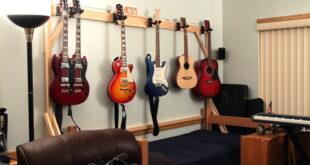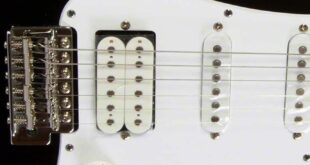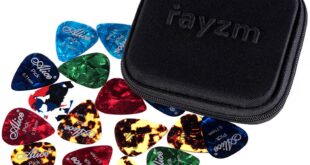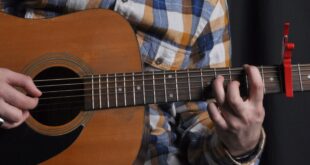Not everybody is familiar with the various sizes and types of acoustic guitars. So, when they’re out to get one, they wind up purchasing the incorrect one? Fit, playability and audio quality are the most crucial considerations when comparing sizes. While small acoustic guitars are simpler to transport, larger acoustic guitars are loud and have a variety of tonal qualities.
A guitar having steel strings is referred to as an acoustic guitar. An acoustic guitar has a hollowed body that sonically enhances the strings’ vibrations. An acoustic guitar doesn’t require external electrical amplification to listen properly. The oscillations of an acoustic guitar’s chords are amplified by the ‘sound box’ (the hollowed body of a guitar) and the ‘sound board’ (front of the instrument).
Acoustic guitars are known for their sharp, metallic tone. The guitar’s tone is affected by the wood used in the construction, the strings employed, if the guitar is played using fingers or a pick, and how the strings are sounded.
The acoustic guitar is indeed a stringed instrument. Whenever a string is pulled, the vibrations are carried from the bridges to the roof of the guitar, where it reverberates. It also travels to the instrument’s sides and back, vibrating through the body’s air and generating music via the sound hole.
A pick (also called a plectrum) is a triangle round piece of plastic used to hit the guitar strings. Compared to playing only with the fingers, playing with a pick provides a louder and crisper tone. However, you may only hit single or neighbouring strings simultaneously by using a pick.
To make the chords sound, solo acoustic guitarists (some who perform solo guitar songs independently instead of accompanying vocalists and other musicians) typically use their fingertips. To boost clarity and loudness, they frequently lengthen the fingernails of the plucking hand.
Right-handed guitarists (including guitarists who compose with the left hands yet play the guitar with a ‘right-handed’ manner) use their right hand to strike the strings, whether with a pick, fingertips, or a thumb.
The fingers of the opposite hand (for most guitarists, typically left hand) are often used to keep the strings in place at the proper fret onto the fretboard (the top of the instrument’s ‘neck’). As a result, the strings resonate at the correct pitch.
The acoustic guitar may be used in various ways, whether as a single instrument or an accompaniment to other performers. Strumming chords is the most popular way of performing an acoustic guitar. (A chord is just a collection of notes that play simultaneously.) Strumming plays chords in a rhythmic pattern to accompany a vocalist or another artist (s). By hitting the chords with a sweep downward and upward motion of the hand, the notes are heard (nearly) simultaneously.
Flatpicking is a technique for playing the guitar using a pick to create more complicated music than strumming chords. Flatpicking involves playing single notes or chords in complex patterns. A solo Flatpicking guitarist may produce the effect of both melody and accompanying in this fashion. This is how you may play the acoustic guitar solo.
The sounds of chords and melody are sounded using the fingers instead of a pick in the fingerstyle acoustic guitar skills. This gives you more control over which tones play at the same moment. A single-fingerstyle guitarist may deliver a complete single performance by playing the bass chords and melody of a piece of music all the time.
Guitars come in a wide range of sizes. You may select from little guitars such as guitarleles, which are similar to ukuleles but somewhat larger, to large acoustics like giant acoustics. This is ideal for an individual if determined by personal choice, physique or arm size, and competence.
A ukulele is the smallest-sized instrument and is excellent for individuals who find standard-sized guitars too large, such as youngsters and those with small fingers. A guitarlele, with the exception of ukuleles, features the standard six strings found on most guitars. These instruments combine the mobility of a ukulele with the flexibility of a standard guitar. A half-sized guitar or half a size of a conventional guitar is the next option. And then there is the three-quarter size of the guitar, which is popular among children aged 8 to 12.
The bigger parlour guitars, theatre guitars, classically styled dreadnoughts acoustic guitar, and the jumbo type follows in size order. Electric guitars offer fewer size options, with the majority falling into half a size, three-quarters of the size, or full-size categories.
Table of Contents
Top Picks:
Pros:
- Travel friendly
- Lightweight
- Sapele on the top, sides and back of the body
Cons:
- Comes with fewer accessories
You get several useful ‘how-to videos with the Stretton Payne 3/4 Guitar bundle to assist you in setting up and tuning the guitar. These quick lessons will show how to digitally utilize your tuner and extend nylon strings to enhance your instrument’s tuning stability.
Getting the correct guitar is crucial when youngsters are learning to play the instrument well. If people find it tough to manage, they may find it far harder to understand. The manufactures created the 3/4 body of the Stretton Payne guitar to make playing more fun with a shorter, easier-to-handle body that doesn’t affect the sound quality of this fantastic guitar. This guitar has a mahogany neck with purple hearts fingerboard, and its body is made of spruce. The sound of this tone wood is smooth, well-balanced, and well-defined. It’s also tough and long-lasting so that the instrument can withstand trips to schools and lessons.
Pros:
- Ideal for youngsters
- An easier-to-handle body that doesn’t affect the sound quality
- Smooth and high-quality sound
Cons:
- Not a lot of options for colour available
With a bigger fretboard to assist with chords positions, this guitar is an excellent choice for beginners. Because of the travel case supplied with this guitar, you can easily get to and from courses or lessons. With carrying straps, you can easily transport this guitar, and the bag can be used for dust-free storing while not in service.
This guitar’s brilliant blue glossy finish ensures that it will blend in well in your classroom setting or home. This guitar also sounds as wonderful as it looks, owing to the amazing tone it produces.
Pros:
- Essential accessory included
- Simple to push down nylon strings
- You can easily transport this guitar
Cons:
- The bag may not be of great quality
The dreadnought body design produces a powerful and booming sound. Hence, they are popular among a wide range of musicians and sound fantastic in any musical genre. A guitar’s bridge is a critical element concerning both operation and tone.
One of its bridge’s most essential functions is to carry audio from the string to the guitar’s audioboard and play a significant role in keeping the strings in position. The D1 bridge is comprised of a solid black tone wood that was particularly picked for optimal sound performance and longevity.
For nearly 20 years, Stretton Payne has produced high-quality harmonious instruments in the United Kingdom. In expansion to using FSC woods in building the tools, Stretton Payne owns 50 acres of forests that are conserved and handled by the firm with the express objective of absorbing greater carbon than what is created by creating and shipping the instruments.
Pros:
- Great for beginners
- D1 bridge is comprised of a solid black tone wood
- FSC wood used in the building of the instrument
Cons:
- A little bit on the heavier side for beginners
The guitar’s elevated qualities and beautiful tone are attributed to its exceptional handmade solid kind of body and brass fret. It is ideal for guitarists over the age of 12 with a stature of over 5 feet. Because of its gorgeous and innovative small-sized design, the ART ALL 39 in guitar is excellent for teens or novices. This guitar has a distinct and beautiful tone that is remarkable and unforgettable.
Completely free presents provide an ideal first-playing encounter, removing the need to hunt out elements one by one. This instrument is worth recommending because of its excellent sound quality.
Pros:
- Innovative small-sized design
- Exceptional handmade solid kind of body and brass fret
Cons:
- Pricy
Buyers Guide:
If you’re shopping for a first or new acoustic guitar, there are some things to keep in mind to ensure you purchase the proper one. This post will teach you how to select the best acoustic guitar to suit your needs. There are many various types of acoustic guitars available, but they all vary in a variety of ways, including:
- Tonewood
- Cost
- Shape
- No electronic or electronics
- No cutaway or cutaway
- Solid wood vs. laminate
- Hardware materials
As you read through the section, make a note of what you believe your choice would be for every element. Factors such as cost, you might just have to face some compromises, but if you carefully jot down the specifications you want, you’ll be able to more quickly decide what you need to get and whatever you can live without.
The first factor you should consider is the guitar’s function that you are contemplating.
Is it a guitar that you’ll be recording with?
Or is it just for jamming around the place now and again?
Will you be collaborating with other musicians and performing other instruments?
Do you need to bring the instrument with you?
What kind of music do you think you’ll be performing?
Do you have any idea what type of tone you’re looking for?
These questions will help you figure out your budget, the form of guitar you require, as well as the material you want to use.
An electric Acoustic or just Acoustic?
Would you be able to play the guitar with some other musicians? Will this necessitate the use of amplification? If that’s the case, you might choose an acoustic-electric guitar. You could mic up a hard acoustic and even connect your personal pickup to that but getting a full setup to be plugged in is so much easier. If you’re considering an acoustic-electric guitar, make sure to hear this both connected in and unplugged before making your selection.
The Ability:
In some respects, ability and money go together. If you’re just starting, you generally don’t want to invest a lot of money on a guitar. You do not want anything that will be completely useless, but at the same time, you also don’t want something that would be ineffective.
There’s no better way to be put off from a beginner guitarist than training on difficult-to-play equipment that sounds bad. Many affordable acoustic guitars will sound great and will be simple to play.
If you’re a more experienced musician who hasn’t yet invested in a better guitar, you’re in for a thrill. Yes, you will have to spend more money, but this is just an investment. You will hear the tone variations that come from such a better-quality guitar if you’ve been performing for a time.
Budget:
Guitars may be as much as $15,000! However, those are at the very top of the pricing scale. There are even some guitars available for less than $100! When it comes to guitars, the pricing range is pretty wide. If you want something which will sound great and be a pleasure to play, there is no explanation why one can’t acquire anything brand new only between $1,000 or $2,000. However, there are many pretty decent guitars below $1,000.
On the other hand, beginners will not need to spend as much. It is a good notion to start with a package as a novice. It usually includes items such as a bag, a tripod, a sling, tuners, and picks. Due to better production processes, even low-end guitars aren’t as awful as they used to be, so novices don’t have to settle for outright garbage if they’re on a budget. You may frequently discover nice guitars in a kit for a great price.
Material:
A guitar comprises several distinct pieces, each of which might be constructed of various materials. Understanding how well the woods used for the guitar’s construction affect the tone can assist you in choosing the right guitar.
The hardware (like the bridge pins, bridge saddle, and nut) would also impact the sound you produce.
Most tops are constructed of spruce, and however, if you prefer a guitar with a powerful mid-range and a warm tone, a Mahogany top guitar can be a wonderful choice for you. You have a lot of options as well as combinations to choose from, and it’s all up to you.
The Strings:
The strings users pick will have an impact on the tone. However, if the tone of the instrument you obtain isn’t exactly to your liking, playing with strings may help you fine-tune your sound until it’s exactly what you want.
The solid wood vs. laminate:
Laminate is less expensive, but solid wood has a better tone. That’s pretty much everything that matters in the end. Well, not exactly, but close enough. Suppose you’re on a limited budget and must buy an instrument with laminate wood. At the very least, look for one with a hardwood top (soundboard).
The top of the instrument is an essential tonewood. If you must laminate, make sure it is on the top and sides. Laminate has one benefit over real wood. Environmental variables such as variations in temperature and relative humidity are less likely to alter it. As a result, it’s more durable and much less prone to dry out and warp if not properly maintained.
In a personal view, the tonal characteristics of solid wood greatly exceed this, but if users live in a moist climate with no or little control on the temperature and relative humidity where the guitar exists – or whether folks are merely an informal guitarist who doesn’t wish to put much effort into having to look after their instrument – or if you require a guitar to end up leaving at your vacation home – lamination is worth consideration.
Non-Cutaway and Cutaway:
This is primarily a matter of personal choice, whether you want easy accessibility to the upper strings or enjoy the aesthetic. A cutaway could be a nice option if you play a couple of leads. Then there’s the issue of audio. Is the acoustic sound affected by the cutaway?
A non-cutaway guitar has a richer, deeper mid-rangy tone, but a cutaway has a brighter, somewhat tinnier edge. Because everybody has diverse preferences, this is entirely a matter of personal choice.
Shape and Size:
Necks are available in a variety of forms and sizes. Some are broader to accommodate a broader fretboard, while others are narrower. The curving section of the neck (the contour of the neck) can also vary. Choose the one that seems most natural to you and the style of play. Fingerstyle guitarists, for example, prefer guitars with broader necks and fretboards.
It’s simpler to play fingerstyle with the greater distance between the chords. A thinner neck or just a flatter slope on the nape of the neck may be preferred by somebody with small hands.
Some people enjoy the sensation of a flatter curvature, while others prefer a more pronounced curve. The wood utilized for the neck must also be considered in terms of the audio.
This will have an influence on quality, but don’t be too concerned about it because the board and body would be making the most impact in terms of sound.
Action:
The activity of your instrument (the distance between the strings and the fretboard) is also vital for playing.
Fretting could be hard if the activity is too excessive, and fret buzz could be an issue if the activity is just too low. However, do not let action be the deciding factor when purchasing a guitar.
It is something you could either modify yourself, assuming you know how you’re doing – or get a guitar technician to adjust for you. If everything otherwise in the guitar is perfect, don’t rule it out just cause of the motion; it can be changed.
Frequently Asked Questions:
What size of an acoustic guitar should a 7-year-old have?
A guitar is a way to go when it comes to acoustic guitars. The body ought to be short and slender enough for them to reach the strings. On a guitar of that scale, they must also control the fretboard well. Some suggest that children should be introduced to full-sized instruments at a young age and allowed to grow with them.
For electrics, in which the body is considerably smaller, and the neck is much thinner, this may work. Acoustic guitars, on the other hand, are larger and thicker. They will obstruct the movement of little arms and hands.
Do these instruments sound differently?
They do definitely as the tone or acoustic guitars’ resonance depends on the empty space. Due to the smaller size of the guitar, this is not as strong as a full-sized instrument.
This is due to a lack of air or space to produce significant volumes. Guitars could also be a little muffled.
That’s the case because the chords have a shorter length to resonate along when the chambers become less resonant. On the other hand, a high-quality guitar will play better than a low-quality full-sized guitar.
Is a guitar with a length of 38 inches considered full size?
Yes, the average size of a full-sized instrument is 38 inches. We mention average because each manufacturer and style offer somewhat varying proportions based on the body shape and head. The scale measurement is a better indicator of whether an instrument is full-size. The scale length refers to the difference between both the nut and the saddle, or perhaps the nut also doubles the 12th fret. The latter assessment is often thought to be more precise.
A full-size instrument has a scale size of at least 25 inches. This implies that even if your guitar is longer or shorter than 38 inches from beginning to end, it can still be considered full-sized unless it possesses the necessary scale length.
Conclusion:
Hopefully, you already have a bunch of information to assist you in making an informed guitar purchase. Keep in mind- everybody has different tastes and preferences, so finding the appropriate guitar for you is a personal decision.
Also, recall that you will almost certainly have to make a compromise. It might be possible to change it when you have the guitar, such as trying alternative strings or saddles/nuts and tinkering with things like the motion of the guitar
You’ll also have to determine all the necessities or must-haves and the nice-to-haves for yourself since the smaller your budget is, the more you will have to sacrifice or compromise.
The form and size of the instrument you should buy are determined by various factors, namely the physical traits and the genre of music users like playing.
 The Occasional Orchestra Learn About Everything Music!
The Occasional Orchestra Learn About Everything Music!








